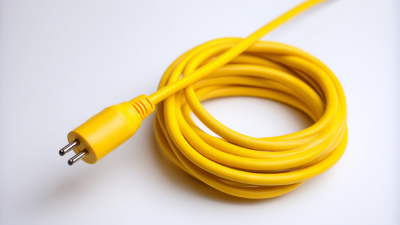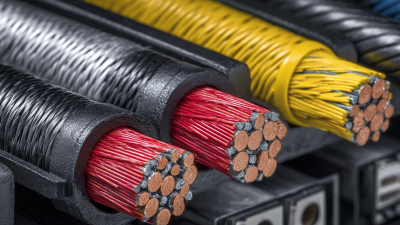-
- Products
- Indoor Household Cords
- Appliance Cords
- General Purpose Short-Length Cords
- General Purpose Extension Cords
- Landscape & Decorating Cords
- Bright Color Extension Cords
- Oil-Resistant Extension Cords
- Cold-Flex Extension Cords
- VividFlex Power Cords
- EXTREME All-Weather Cords
- Cord Management
- Task Lights
- Adapters & GFCI Devices
- Where to Buy
- About
- Careers
- Glossary
- Catalog
- Products
- Indoor Household Cords
- Appliance Cords
- General Purpose Short-Length Cords
- General Purpose Extension Cords
- Landscape & Decorating Cords
- Bright Color Extension Cords
- Oil-Resistant Extension Cords
- Cold-Flex Extension Cords
- VividFlex Power Cords
- EXTREME All-Weather Cords
- Cord Management
- Task Lights
- Adapters & GFCI Devices
- Where to Buy
- About
- Careers
- Glossary
- Blog
-
-

Understanding the Importance of Cord Wire Specifications in Electrical Projects for Enhanced Safety and Performance
In the realm of electrical projects, the significance of adhering to precise cord wire specifications cannot be overstated. A comprehensive understanding of these specifications is crucial for ensuring both safety and performance. According to a report from the International Electrotechnical Commission (IEC), improper selection of cord wire can lead to equipment failures, electrical hazards, and even catastrophic incidents, resulting in significant financial losses and safety risks for personnel. The demand for stringent standards in cord wire usage is therefore an imperative for projects within the electrical industry.

Expert insights further emphasize this importance. Dr. Emily Porter, a leading authority in electrical engineering and safety standards, asserts, "The right cord wire specification is not just a guideline; it is a critical component in safeguarding systems and preventing failure." Her statement highlights the essential role that cord wire plays in the overall functionality of electrical systems. As wire specifications dictate the safe handling of electrical loads, understanding and implementing these standards effectively can enhance both operational safety and efficiency.
Thus, the importance of cord wire specifications extends beyond technical compliance; it is a fundamental element in designing safe and reliable electrical applications. As we explore the nuances of cord wire specifications, we will illuminate the intricate relationship between these parameters and the safety and performance of electrical systems.
Table of Contents
[Hide]
Key Factors Influencing Cord Wire Specifications in Electrical Projects
Cord wire specifications play a crucial role in electrical projects, directly impacting safety and performance. Several key factors influence these specifications, including
wire gauge, insulation material, and environmental conditions. The wire gauge determines the amount of current that can safely pass through without overheating, making it essential for preventing electrical fires or equipment damage. Additionally, the choice of insulation material affects the wire's
durability and resistance to environmental factors such as moisture, chemicals, and UV exposure.
When selecting cord wire for electrical projects, keep these tips in mind:
- Always refer to the National Electrical Code (NEC) or local regulations to ensure compliance with safety standards.
- Consider the specific application and load requirements to determine the appropriate wire gauge, as using an undersized wire can lead to overheating.
- Choose insulation materials that are suitable for the project's environment, ensuring long-lasting performance and safety.
As the global wire and cable materials market continues to expand, projected to grow significantly by 2032, understanding and adhering to proper cord wire specifications will be more important than ever to ensure both safety and performance in electrical installations.
The Role of Material Quality in Ensuring Electrical Safety and Efficiency
The quality of materials used in electrical projects plays a crucial role in ensuring safety and efficiency. High-quality cord wire specifications are essential for minimizing the risks of electrical fires and failures. As illustrated by recent developments in the industry, manufacturers are increasingly integrating recycled materials into their products without compromising performance. This shift not only enhances sustainability but also demonstrates that material quality is fundamental for reliable electrical systems.
In electrical applications, utilizing superior materials, such as advanced polyamides, significantly contributes to both safety and efficiency. These materials undergo rigorous testing to ensure they can withstand various environmental conditions while maintaining necessary performance standards. The implementation of innovative materials like these reflects a growing recognition of the need for enhanced electrical safety in projects, particularly as energy efficiency becomes more critical in today’s world. By prioritizing the use of high-quality materials, electrical projects can achieve greater longevity and reliability, ultimately safeguarding users and enhancing overall functionality.
Understanding Voltage Ratings and Their Impact on Wire Performance
Voltage ratings are crucial when selecting cord wires for electrical projects, as they determine the maximum voltage the wire can safely carry without risking insulation breakdown or overheating. Higher voltage ratings generally allow for larger electrical loads, making them suitable for industrial applications where heavy machinery operates. Conversely, if a wire with an insufficient voltage rating is used, it can lead to failure under normal operational conditions, potentially resulting in severe safety hazards, including electrical shocks and fires.
Understanding voltage ratings also impacts wire performance in terms of resistance and efficiency. Wires with appropriate voltage ratings will maintain optimal current flow with minimal energy loss. In contrast, using wires rated for lower voltages can create excessive resistance, leading to overheating and diminished performance. Ensuring that the chosen wire meets the voltage requirements of the specific application not only enhances performance but also extends the lifespan of electrical systems, making it a fundamental aspect of any successful electrical project.
Understanding the Importance of Cord Wire Specifications in Electrical Projects for Enhanced Safety and Performance
| Wire Type | Voltage Rating (V) | Current Capacity (A) | Insulation Type | Application Area |
|---|---|---|---|---|
| THHN | 600 | 20 | Nylon | General Wiring |
| UF | 600 | 20 | PVC | Underground |
| MTW | 600 | 18 | Thermoplastic | Machine Tool Wiring |
| SJOOW | 300 | 20 | Rubber | Portable Tools |
| XLPE | 1000 | 30 | Cross-linked Polyethylene | Industrial Applications |
Essential Regulations and Standards for Cord Wire in Electrical Applications
In electrical applications, adhering to essential regulations and standards for cord wire specifications is crucial for ensuring safety and optimal performance. Various organizations, such as the NEMA and the IEEE, have established guidelines that dictate the acceptable ranges for wire gauge, insulation materials, and voltage ratings. These standards are designed to minimize the risk of electrical hazards, including short circuits and overheating, which can lead to catastrophic failures.
Additionally, compliance with local and international regulations, such as the National Electrical Code (NEC) in the United States, is paramount for any electrical project. These regulations provide a framework for selecting the appropriate cord wire based on its intended use, environmental conditions, and load requirements. Choosing the right specifications not only enhances safety but also contributes to the longevity and reliability of electrical systems, thereby reducing maintenance costs and potential downtime in industrial and residential settings. Understanding these standards is essential for professionals working in the electrical field, ensuring that their projects meet legal requirements while also prioritizing user safety.
Common Mistakes to Avoid When Selecting Cord Wire for Projects
When selecting cord wire for electrical projects, several common mistakes can compromise both safety and performance. One frequent error is underestimating the wire gauge needed for the specific application. Using a wire gauge that is too small can lead to overheating and potential fire hazards. It is essential to assess the power requirements of the devices being connected and choose a wire gauge that can adequately handle the load.
Another mistake involves ignoring voltage ratings. Each cord wire has a designated voltage capacity, and neglecting to verify this can result in insulation breakdown and failure. Additionally, it is crucial to consider environmental factors—such as exposure to moisture or extreme temperatures—when selecting cord wire. Failing to choose wires rated for outdoor use or adverse conditions may lead to premature degradation and dangerous situations. By avoiding these common pitfalls, project managers and contractors can ensure safer and more reliable electrical installations.




